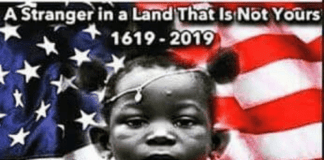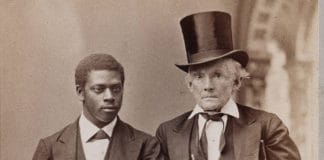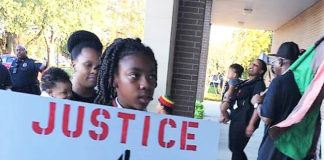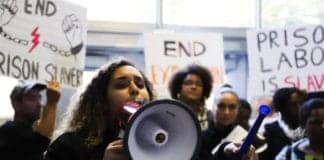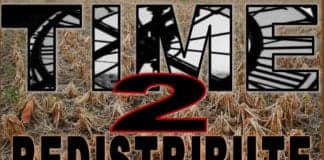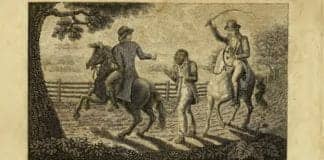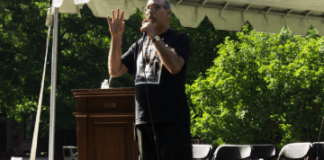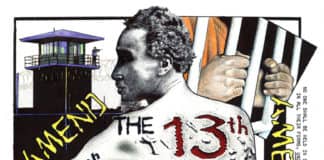Tags Convict leasing
Tag: convict leasing
Pattern of practice – brutality, schemes and crimes against humanity since...
Mutope Duguma defines the path from 1619’s forced exportation of Afrikans through the 400-year evolving in the domestic colonized nation to New Afrikans in the protracted struggle of present day.
Marxists, Smarxists: Black Lives Still Matter
Black Lives Matter no matter how you embrace or argue it – we are in the reckoning and there is no going back. Trying to figure it out from the head will get you wherever it gets you. Go to the heart and you will be there.
Register, vote (y)our interests and continue organizing for power!
Vote and register (y)our interests for changes and recovery from this ongoing deadly coronavirus pandemic; deepening imperialist monopoly capitalist economic depression; worsening corporate abuse of Mama Nature; European and american “white” terrorist wars against The People.
How did the slavery clause get into the 13th Amendment?
Lincoln was a proponent of the convict lease system and saw it as a restricted form of slavery that the state could exploit and the people would accept. He said as much clearly in his letter to Alexander H. Stephens just four months before the start of the Civil War. [Alexander Hamilton Stephens was vice president of the Confederacy during the Civil War, 1861-65.]
The Sugar Land 95: Help us protect the sacred burial ground...
On the front page of USA Today for Dec. 27, 2018, we saw a shocking headline: “Grave discovery unearths legacy of Black convict labor.” The unmarked graves of 95 “prison slaves” were found on a construction site in Sugar Land, Texas. These Black men, ages 14 to 70 years old, were our ancestors and the first victims of what we have come to know as prison slavery in Amerika! These contract convict laborers were subjected to this form of slavery because the 13th Amendment of the U.S. Constitution still allows slavery. Only the name has been changed. Slavery is still alive!
Call for a Juneteenth 2018 Mobilization Against Prison Slavery
This year we, the undersigned, are calling on all opponents of mass incarceration and modern-day slavery internationally to honor the Juneteenth holiday – Tuesday, June 19, 2018 – with community organizing and direct action. This call to action is inspired by prisoners in Texas and Florida, two of the largest and most repressive prison systems in the U.S., who remain active in freedom struggle against all odds.
This ‘modern-day’ slavery isn’t all that modern
Today as I write this article I am sitting in one of Alabama’s prisons looking around at the many lost, confused and content slaves who occupy the overcrowded slave quarters called Alabama Department of Corrections. The task that I, Brother Ra Sun and Kinetic Justice have before us is to convince these brothers on today’s modern day plantations; they are still slaves, made applicable by the 13th Amendment of the United States Constitution, and are contributing to their enslavement. Unfortunately, I’ve yet to find the best way to do that.
Mass incarceration for profit: The dual impact of the 13th Amendment...
The 13th Amendment reads in Section One: “Neither slavery nor involuntary servitude, except as a punishment for crime whereof the party shall have been duly convicted, shall exist within the United States, nor any place subject to their jurisdiction.”
Understanding this contradictory character of the 13th Amendment sheds light on the utilization of the criminal justice system in the perpetuation of bondage for the purpose of institutional racism and class exploitation.
It’s not mass incarceration, but slavery
Speech delivered at the Millions for Prisoners Human Rights March Aug. 19, 2017, in Washington, D.C.: Let me tell you what’s going on here today. This is the largest gathering of slavery abolitionists in the history of the United States, happening right here today. In 16 cities across America, they are marching in unison with us and in solidarity with us, and they’re not doing it to end mass incarceration. They’re doing it to end what? (Slavery!) Slavery.
On Dec. 6, 1865, Black bodies were nationalized – and our...
As I write this article, I am not sure what day the Civil War began or what day it ended. The facts that I do know about the Civil War are not worth repeating here, as that story already occupies plenty of space in American text. My muse, instead, is about the particular vestige of slavery that the Civil War bequeathed to us on Dec. 6, 1865, that now forms the basis of our struggle to end mass incarceration and prison slavery in 2017.
Announcing Millions for Prisoners March for Human Rights
The purpose of this press release is to notify prisoners, community organizers and all those who care of the upcoming Millions for Prisoners Human Rights March in Washington, D.C., scheduled for Aug. 19, 2017. This is a national effort to bring world attention to the 13th Amendment enslavement clause, its ramifications, and to solidify organizing efforts to amend it. In essence this is an abolitionist movement to abolish legalized enslavement.
George Jackson University supports the historic Sept. 9 strike against prison...
Sept. 9, 2016, is the day that many people in America are wholeheartedly organizing, mobilizing, taking action, standing and locking arms in solidarity against what we know as prison slave labor – yes, legalized slavery – and people are saying, “No more!” Even though there are many taking action and answering the call to cure this particular ill of society, there is an overwhelmingly larger portion of the U.S. population who are absolutely clueless to the fact that slavery still exists.
Battling the fear of ‘our’ kids
From it's inception, the juvenile justice system has treated youth of color unfairly: When the first detention facility established a "colored section" in 1834, Black children were excluded from rehabilitation because it would be a "waste" of resources.




